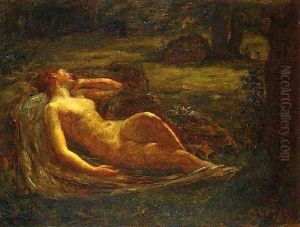Wyatt Eaton Paintings
Wyatt Eaton, born on May 6, 1849, in Philipsburg, Quebec, Canada, emerged as a distinguished figure in the American art scene during the late 19th century. His journey into art began at a young age, leading him to New York City where he furthered his education at the National Academy of Design. Eaton's quest for artistic mastery took him to Europe, a common practice among his contemporaries, where he studied at the École des Beaux-Arts in Paris under the tutelage of Alexandre Cabanel. During his time in France, Eaton was deeply influenced by the realist and naturalist movements, which significantly shaped his artistic style.
Eaton's body of work is primarily known for its realistic portrayals of human figures and portraits, a genre in which he excelled and gained considerable recognition. His attention to detail, use of light, and ability to capture the essence of his subjects earned him a reputable place among American realist painters. Eaton was not just a painter; he also contributed to the art world through his teachings and writings, advocating for the importance of drawing as a fundamental skill for artists.
In 1872, Eaton became one of the founding members of the Society of American Artists, an organization established in protest against the conservative practices of the National Academy of Design. This society aimed to promote a more progressive and inclusive approach to art, reflecting the changing dynamics of the American art scene during that period. Through his involvement, Eaton played a crucial role in shaping the direction of American art, pushing for innovation and the exploration of new ideas.
Despite his contributions and relatively successful career, Wyatt Eaton's life was cut short when he passed away on June 7, 1896, in Newport, Rhode Island. His legacy, however, continues to be celebrated through his artworks and the impact he had on the American art world. Eaton's dedication to realism and his effort to elevate the standard of fine art in America have cemented his place as a significant figure in the history of American art.





